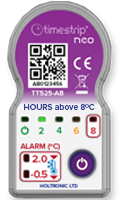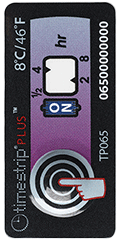Time and Temperature Indicator maker Timestrip launches the Timestrip® Temperature app, a new tool that provides a visual audit trail of its temperature products.
Frame
Zoom
Focus
Snap
Using the App simply involves taking a photo of a Timestrip® label with a smartphone.
If the Timestrip® has a new style serial number, the App will recognise the serial number and allow you to register it on the system.
You can then take a follow on scan where you can enter its activation state (inert, activated or breached), storing this data with essential time and location information in the cloud.
If the Timestrip® has an old style serial number you can still use the app in the same way but you'll need to manually enter the serial number. The App is free to download from the Google Play store with an iOS version to follow shortly.
High tech low cost
The App is the latest innovation from Timestrip, which revolutionised the field of cold chain management with its unique Irreversible Time and Temperature Indicator labels (TTIs).
Recognised by the World Health Organisation and the US FDA as an essential tool for the cold chain management of blood and food products, TTIs provide data as to whether a blood or food product is safe to use. Timestrip’s irreversible TTIs make this crucial safety information unambiguous and instantly visible.
Like having a hundred permanent digital data loggers
The main benefit of Timestrip’s irreversible TTI labels is that they give essential cold chain management information on individual units of processed products. This deals with the main shortcoming of digital data loggers, which are mostly used for containers of transported and stored products.
Thanks to the new Timestrip® App, extra key information around cold chain management is added with the safe storage of status, time, journey and location data, which can be accessed at any time via the app or via a website. A digital data logger can be lost or damaged and all its data can be wiped clean. The Timestrip® App however safely stores this data in the Cloud.
Data logger functionality at a fraction of the price
Timestrip UK CEO Reuben Isbitsky says: "I am very excited about our first App, which brings Timestrip TTI labels very close to data logger functionality, at a fraction of the price. While a key benefit of Timestrip products is that they do not need external infrastructure to read and interpret, using the optional Timestrip Temperature App to scan them, adds enhanced functionality, easy audit trail and provides the customer with a permanent record of the history of the product’s journey."
Content by MW Communication
Already in 2012 the world’s third largest importer of seafood, the UN's Food and Agriculture Organization predicts that China in 2016 is set to become the world’s top destination for seafood imports. Key economic data and trends point to further growth in domestic consumption and, despite indications that the country’s economy is slowing, it has nevertheless trebled in size since 2001, with Forbes magazine predicting it will surpass the US in scale in 2018.
This growth in China’s seafood imports comes at a time when the seafood sector generally is in excellent shape, growing at a faster rate than any other protein industry with the world’s top 150 seafood companies generating $107bn in sales in 2015.
Unsurprisingly, China’s top suppliers are almost all situated around the Pacific basin. In 2013, Russia was in first place with a 17.8% share followed by the US (15.3%), Peru (12.1%), Chile (5.3%), Norway (5.1%) and Canada (4.8%), with other seafood imports being sourced from over 100 other countries. That year in value terms, its main seafood imports included flours and meals of fish, used in animal feeding ($1.7 billion); frozen Alaskan pollock ($883.6 million); frozen cuttlefish and squid ($445.9 million); and frozen cod ($434.0 million).
This astonishing growth in seafood imports is explained by a variety of factors:
Firstly, higher Chinese incomes have fuelled an increase in domestic demand: between 2001 and 2014, real wages in China rose fourfold and this trend is ongoing. Data from the Economist Intelligence Unit point to national average urban incomes rising by around 70% between 2012 and 2017, from US$6,291 to $10,791.
Moreover, this increase in domestic demand includes that for high-end seafood imports, such as lobsters come from France, Canada and the US; abalones from South Africa, Australia, and New Zealand; red shrimps from Ecuador and Argentina; king crabs from Russia and Chile; salmon from Chile, Ireland, Scotland, and Norway; and oysters from America, France, and New Zealand. Such products are obviously favoured by wealthier Chinese consumers, but the country’s emerging middle class is also demonstrating a growing appetite for these seafood imports.
An indication of this trend is the recent news report that the Russian Caviar House has begun exporting black caviar to China, with regular annual shipments of 100-150 kilograms currently being planned, according to company director Saodat Sultanova.
The second key factor explaining the growth in China’s seafood imports is that its domestic production capacity has been extremely adversely affected by pollution and thus cannot meet this increase in demand. Indeed, despite it being the world’s biggest seafood exporter, double in value terms of its nearest rival, Norway, the environmental impact of its breakneck economic growth in the last 20 years has created an insurmountable environmental obstacle.
In March this year, China’s Agriculture Minister Han Changfu said: “… the increase in China’s seafood output has come at the expense of the country’s natural environment.” Han also said that the production capacity of the country’s environment has been stretched to breaking point, with various measures undertaken this year to address the situation. These have included the launch of an effort to protect and repair its freshwater fishery resources, an increase in its annual fishing ban on the Yangtze River from three months to four and an extension to the ban to local rivers and lakes. Such actions will inevitably impact negatively on aquaculture hubs like Jiangsu and Hubei, since the Yangtze flows through those areas and means that China is having to source its seafood elsewhere.
Such environmental issues also affect the safety of China’s domestic seafood production, leading to consumers avoiding potentially harmful products.
In 2012, the Ministry of Agriculture (MOA) published administrative measures on the control of agricultural product (including aquatic) quality and safety, which included regulations on risk monitoring and sampling. Also since 2012, a further regulation is that food and beverage exporters to China are required to register through the General Administration of Quality Supervision, Inspection and Quarantine (AQSIQ)
Despite these measures, in November 2016 it was reported that Chinese seafood retailers are increasingly nervous about stocking domestic seafood, which may have excessive traces of antibiotics. Sales outlets are also beginning to eschew selling live seafood, a choice favoured in particular by older Chinese shoppers, who traditionally bought these products from supermarkets and wet markets. Retailers say they are concerned about costly closures caused by failed safety inspections by food hygiene officials. Meanwhile central government affirmed that the safety scare wasn’t due contaminated water in live fish tanks.
This explains another key trend: the growing importance of place of origin for Chinese consumers. The market for seafood from Canada and Alaska for instance have continued to develop, with northern prawns and Canadian lobsters especially popular. Indeed, advertising the places of origin is set to become an ever more important aspect of marketing seafood imports in China, especially where the source is trusted for its rigorous temperature controls and requirements.
Demand for such products is further stimulated with Chinese consumers’ own ongoing positive experience around product quality, texture, safety, etc, all of which is inextricably linked to effective temperature control monitoring throughout the cold chain process.
The regulatory framework for importers is complex. Beyond having to satisfying country origin export regulations around documentation (commercial invoice, packing list, export health certificate, certificate of origin, etc), all products on cross- border platforms such as Kuajingtong, should meet all the requirements set by Chinese regulations, including Chinese language labelling, certification and registration standards.
Also that year, China updated its Food Safety Law, affecting ingredients, testing methods, manufacturing, contact substances, packaging, and nutrition labelling. Two important regulations, including a “Food Traceability System” and “System of Real Name” have been established and allow consumers to require a “continuous compensation”.
Lastly, Chinese regulations can change quickly and therefore it is important for importers to remain up to date with all policy changes. For example, since 2014, China has banned the imports of whole salmon, but not processed salmon.
That said, this know how around regulations is clearly not an obstacle to the many companies already exporting seafood products to China and a major trend moving forward is predicted to be around the development of e-commerce for the sale of imported seafood products.
Fan Xubing is the founder and president of Sea Bridge Marketing in Beijing and has worked for many years as a partner in promoting sales of imported seafood in China, especially online. He says that 2015 saw a rapid development of e-commerce business of imported food generally. Sales of such products including seafood have increased by over 50% and Chinese consumers are becoming accustomed to buying seafood products online.
He also says that 2016 has seen many improvements in cold chain logistics, tighter controls over temperature and more effective regulation related to seafood safety. He points to e-commerce firms such as Jingdong and Womai, which increased their investment in their cold chain logistics, and how it has become increasingly common for Chinese consumers to get the products on the day they order online or the following day.
China’s seafood import sector has been given a significant further – and often underreported – boost with the decision by central government in recent years to allow more regional cities to handle imports of perishable goods, simplifying a significant aspect of import logistics.
In the capital of comparatively wealthy Jiangsu province for instance, this has led to imports of seafood trebling and in Suzhou, which started handling seafood imports in 2015, the AQSIQ predicts more than 1,000 tons of fresh salmon will be imported into the city in 2017. The AQSIQ also reports that this year Nanjing’s Lukou Airport handled 300 tons of salmon from Chile, the Faroe Islands, the UK and Australia.
This surging demand for seafood imports has had, and will carry on having, a profound impact on cold chain logistics. According to market research by ReportLinker, in an environment where most cold chain logistics enterprises often operate both a cold storage and transportation business, the circulation in China of cold chain agricultural (including aquatic) products reached 330 million tonnes, up 16% year on year, and this is projected to double by 2020.
Maintaining a correct cold chain is essential in managing the supply of seafood products in order to avoid contamination and food poisoning, especially from C Botulism. For restaurants and retailers, who are towards the end of a typical cold chain, ensuring this has occurred prior to delivery is a particular concern. Failure in this area can have dire consequences, both in cost and PR terms, and for consumers, they can be extremely dangerous and in some cases lethal.
C Bot seafood recall alert
In June for instance, the FDA website published an alert about a Florida-based supplier of tuna products that was obliged to initiate a US-wide product recall due to suspected C Botulism contamination of its product.
The manager of one major London restaurant says that the main ways his establishment monitors the quality of the seafood it orders are visual and olfactory inspection of the product upon receipt and the use of trusted suppliers that have the correct certification. The products are also checked upon receipt with temperature probes.
He says that a contaminated seafood product will “not look right”, that it will look “sweaty” and for fish as opposed to shellfish, that the eyes of fish that have “gone off” will look “dead looking”.
He also says that contaminated fish will have a distinct unpleasant smell and that his rule of thumb is “discard fish that smells fishy”.
He says that the scenario of the refrigerated delivery truck whose engine was switched off for a number of hours prior to delivery needn’t necessarily lead to a fall in the refrigerated ambient temperature within it as long as the truck’s doors haven’t been opened.
He adds that major points of sale of seafood products such as Billingsgate market in south-east London have power points specifically to ensure that the refrigeration units of delivery trucks are kept on, thus ensuring that the seafood products they are carrying are kept at the correct cooled or frozen temperatures.
He does concede though, that for oysters specifically, in his 40 years’ experience as a restaurant professional, statistically all restaurants that offer them will occasionally serve oysters that lead to food poisoning.
Lastly, he says that in his experience restaurants are extremely rigorous in the correct application of good food management principles and most cases of food poisoning from contaminated seafood in fact occur in private residences where there is much less awareness of these principles.
Furthermore, he says that among people who aren’t professionals of the food industry, there is also a poor understanding of food poisoning and in all suspected cases enquiries are always made about what was eaten in the previous 72 hours as invariably the cause of the incident was not what was last consumed.
Across the Channel in France, a similar approach also exists with a specialist Marseille-based seafood restaurant and retailer that has two busy branches and has been operating for over 60 years.
The manager of this business, who deals the most with quality and cold chain monitoring, says for him visual inspection of seafood products upon receipt of new stock is his most useful tool to determine whether an appropriate cold chain has been maintained.
He says fish that is spoiled due to not having been kept at the correct cooled temperature will “not feel right” and “not have the right firmness”. This, he says, occurs even before the product starts to smell bad.
He also knows that fish that is spoiled always have eyes that are not the correct colour, which is another indication that they haven't been kept at the correct chilled temperature prior to delivery.
Another aspect of how his restaurant ensures the quality of the products they serve is to only use trusted suppliers and not to deal with intermediaries. Because of these strong longstanding relationships, his business benefits from a “no questions asked” returns policy.
He also says experience is also key, pointing to the 60+ years his establishment has been in existence.
However, like his counterpart in the UK, beyond many years’ professional experience and the use of trusted suppliers and mainly visual inspection of seafood products upon receipt, no cold chain monitoring tools are used.
Both also were emphatic about stressing the value of their respective establishment’s reputation and how damaging an outbreak of food poisoning would be. This, they both said, was always one of the main issues at the front of their minds when they managed their seafood products.
However at one of Marseille’s main teaching hospitals, one senior nurse was extremely dubious about how restaurants manage and monitor seafood cold chains. Her many years’ clinical experience was that they often cut corners and few would discard products that might be spoiled, but could not be returned, due to the appropriate cold chain not having been maintained. She also said she thought this extremely worrying situation would occur even if sophisticated temperature indicators were used at all stages of the seafood cold chain.
Seafood safety and quality can be compromised when exposed to temperatures that are either too high or too low. The Timestrip Seafood Temperature Indicator monitors the ascending temperatures of fresh seafood in reduced oxygen packaged seafood where C.botulinum toxins can develop undetected above 3.3°C / 38°F.
FDA C. Bot. HACCP plans for seafood imports
Clostridium botulinum (C. botulinum) forms toxins faster at temperatures above 3.3 degrees Celsius. The Timestrip Seafood Indicator is set at 38°F / 3.3°C and allows you to monitor if there is a possibility that these toxins have formed because of the temperature breach.
FDA guidance requires fish importers and processors to develop and implement a Hazard and Critical Control Point (HACCP) plan for addressing supply chain dangers including temperature abuse. With the Timestrip Seafood Indicator, seafood handlers know just by looking at the indicator if a temperature breach has occurred.



